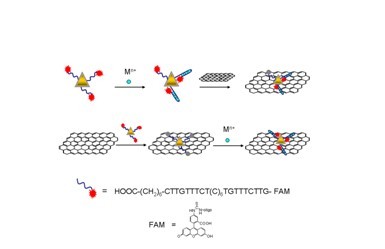Recently, scientists in Institute of Intelligent Machines of Chinese Academy of Sciences, Anhui, have developed new fluorescence protocol for trace detection of mercury ions in drinking water.
Safety of drinking water are being widely concerned around the world due to increasing threat of pollutants in the aquatic ecosystems and severe effects on human health. Therefore, exploring sensitive, highly selective and cost-effective approach for determining contaminations and evaluating safety of drinking water are quite important and attemptable.
Under the support of National Key Scientific Program-Nanoscience and Nanotechnology (Grant No.2011CB933700), Prof JinHuai Liu, Jin Wang and LingTao Kong at the Research Centre for Biomimetic Advanced Materials and Sensing Devices, designed a novel hybridized fluorescence protocol based on fluorescence quenching of graphene and enhancement of nanogold for highly sensing of mercury ions in water. The relevant paper has been published on RSC journal <<Chemical Communications>> DOI: (10.1039/C1CC13601a). “The protocol is comprehensive combination of the present nanotechnologies and nanomaterials, and unity of contradictory concepts. The sensing scheme proposed is interesting and of potential general applicability.” says the specialists.
Besides extensive investigations on inorganic contaminations, a series of progess in trace-detection of organic pollutants have been done by us. The scientists utilized cyclodextrin decorated nanomaterials, e.g., carbon nanotubes, nanogold, for realizing sensitive analysis of aromatic pollutants via photon or electrical singals. The relevant papers have been published on RSC journal << Journal of Materials Chemistry >> (J. Mater. Chem.,2010, 20, 5271), (highlight in Chemcial Technology 2010, 6) 和 (J. Mater. Chem.,2011, 21, 11109) (Back cover: 2011, 21,11440).
On the basis of aforementioned researching progress, the scientists in Institute of Intelligent Machines will continue to develop novel optical detection approach and protocol by using nanomaterials with excellent optical properties for achieving ultrasensitve detection of pollutants in aquatic ecosystem.

“FRET/SIMNSEF” protocol for detection of mercury contaminations based on graphene/nanogold